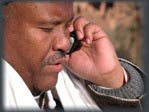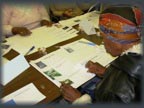My research contributes to the fields of Human Computer Interaction (HCI), Computer Supported Cooperative Work (CSCW) and Health Informatics. My work is further
informed by methods, theory and empirical findings from the fields of public health, sociology, and health communication. The main focus of my research is designing and
evaluating the impact of software tools that help people move towards improved health and wellness.
I am passionate about studying how technology can help reduce racial, ethnic, and economic health disparities. For example, I have studied
how culture and environment affect health behaviors and attitudes, and how health technologies can account for this relationship. In this work
I have addressed diet-related health challenges in low-income, predominantly African American communities. I have also studied other aspects of health, such as
health monitoring and reflection for individuals and families.
My other research has examined the role of technology in human-food interaction and the digital calendaring needs of working parents.
Current Work
For a list of my current projects, visit the Wellness Technology Lab research projects page.
Previous Work
Pediatric Health Promotion
Supporting health literacy in an engaging way
 with Dr. Elizabeth Mynatt, Dr. Veda Johnson, Ian McClendon, Catherine Grevet, Victoria Ayo, and Wontaek Chung
with Dr. Elizabeth Mynatt, Dr. Veda Johnson, Ian McClendon, Catherine Grevet, Victoria Ayo, and Wontaek Chung
In this work I explored how technology can support health promotion in children and adolescents, by making learning about healthy living (e.g., nutrition, physical
activity) an enjoyable
and engaging experience. For example, I am interested in how ICTs can help kids develop healthier food preferences and nutritional literacy.
To start, we developed TalkBack, an online forum that encourages kids to collaboratively "talk back" to food advertisers by
critically deconstructing food advertisement messaging
and reflecting upon their own food preferences. In a pilot study, we examined participants' use of TalkBack and identified barriers to critical thinking. Our findings also
suggest the importance of understanding the identity work that adolescents engage in when using a tool such as TalkBack.
Finally, through subsequent participatory design workshops, our participants developed new ideas for social online environments that promote healthy eating.
CHI'13 paper on this research to appear.
[back to top]
Community Mosaic
Collaborative system for visually documenting and sharing healthy eating ideas
 with Dr. Beki Grinter, Vasudhara Kantroo, Heerin Lee, Miguel Osornio and Mansi Sharma
with Dr. Beki Grinter, Vasudhara Kantroo, Heerin Lee, Miguel Osornio and Mansi Sharma
We designed and implemented Community Mosaic, an application that allows members of local communities to share MMS and SMS messages
documenting how they are successfully eating well in their local neighborhoods. Once these messages are sent to our system, they are
visualized on a large touchscreen display application that we installed in a local YMCA branch.
In this visualization, anyone going into the YMCA can see photos and text
describing practical, locally-relevant ideas for healthy eating, including recipes, meals at local eateries and products sold at local supermarkets.
Viewers can also share their reactions to the content in the system, for example by pressing a button to indicate they were inspired to try the idea being shared.
We conducted a three month field study to
examine what made shared content engaging and the impact of sharing and viewing messages on individuals' knowledge about healthy eating. We also examined how using
Community Mosaic impacted users' confidence in their ability to encourage others in the community to eat well and their attitudes regarding the importance of engaging
in such health promotion.
CHI'12 paper on this research: [PDF].
[back to top]
EatWell
Collaborative system for sharing spoken reflections on nutrition in a local community
 with Martin Bednar, Dr. Jay Bolter, Dr. Beki Grinter
with Martin Bednar, Dr. Jay Bolter, Dr. Beki Grinter
I designed and implemented an application called EatWell
that allows people to use their cell phones to create and share short audio memories describing how they
have tried to eat healthfully in their neighborhood (e.g. at fast
food restaurants or when cooking at home). They can also listen to the memories
that others in their local community have created. The system
design thus leverages the existing and culturally-situated knowledge
of the community, and as such helps individuals to learn new
culturally-grounded strategies for healthy eating. I studied the appropriation of EatWell in an urban neighborhood in Atlanta, GA over the course of 4 weeks.
I used interviews, surveys, and system log data to analyze how and why people used the application.
One of the key findings in this study was the way in which using EatWell facilitated a sense of community empowerment amongst users.
CSCW'08 paper: [PDF]
CSCW'10 paper: [PDF]
Journal of Diabetes Science & Technology (2011) paper:
[PDF].
[back to top]
OrderUP
Mobile phone game about nutrition
 with Vasudhara Kantroo, Dr. Beki Grinter
with Vasudhara Kantroo, Dr. Beki Grinter
We designed and implemented a mobile phone game called OrderUP! in which the
goal is to help players learn strategies for healthy eating in a fun and
lightweight way. Our goal with this game was to address the nutrition-related health disparities in low-income African American communities.
In OrderUP!, users play the role of a server in a neighborhood restaurant. Their patrons are members of the local community and their goal is to
serve their customers as quickly and healthfully as possible. In particular, players must choose the healthiest options from amongst dishes common at fast food
restaurants and "soul food" establishments. Thus, the player must select from items that would realistically be available in the neighborhoods that we are focusing upon.
Players gain points by serving customers quickly and by recommending the healthiest food options to players.
We conducted a field study of this game to examine participants' reactions to the game, the affects
of the game on their health-related attitudes and behaviors, and how the game affects nutrition-related dialogue with individuals in the players' social network.
UBICOMP'10 paper on this research: [PDF].
[back to top]
Examining the Culture of Nutrition
Deriving design implications for culturally-focused health technology
 with Sheena Lewis, Sarah Williams, Dr. Beki Grinter
with Sheena Lewis, Sarah Williams, Dr. Beki Grinter
We worked with REACH for Wellness,
to recruit participants for a study to better understand the health attitudes
and beliefs of individuals from underpriveledged communities in the Atlanta area. This understanding helped
us understand which aspects of health behavior future technologies should target. In this study, we
used focus groups to examine questions such as "What does it mean to be
healthy?" In addition, we used participatory design sessions to help participants convey to us
what types of health-promoting technology they would like to use.
Designing Persuasion
Design-focused analysis of previous health-related research
 with Dr. Beki Grinter
with Dr. Beki Grinter
We studied how health behavior, persuasion theory, and studies of culture & nutrition can be
used to provide a foundation for HCI research on health. For example, the public health community has overwhelmingly advocated that
interventions need to take into account for the cultural affects on
health practices. By looking at previous work within the public health
and nutrition domains, we derived three aspects of this research that
are important for technology designers to take into account.
Persuasive'07 paper on this research: [PDF].
[back to top]
Family Health
Formative qualitative fieldwork to dentify design implications
 with Dr. Desney Tan, Dr. Dan Morris
with Dr. Desney Tan, Dr. Dan Morris
While medical research has shown how the family unit affects individual health behaviors, little work has been devoted to examining the role of the family
in HCI health research. We addressed this gap in research, looking particularly at parent-children relationships and
supporting health discussions within the family. To explore this
domain, we conducted a study comprising a week-long journaling
activity followed by semi-structured interviews and formative design
activities with 66 people in 15 families. We examined the implications of collecting, sharing, and viewing
health information in the family context.
GROUP'09 paper on this research: [PDF].
[back to top]
FotoFit
Design concept for a diet and exercise reflection tool
 with Brandon Brown, Marshini Chetty, Ellie Harmon
with Brandon Brown, Marshini Chetty, Ellie Harmon
We designed FotoFit, a low-fidelity prototype for monitoring diet and exercise habits.
Fotofit allows users to record their diet and exercise habits by taking quick snapshots (using their camera phone) of
the foods they eat and the physical activity that they engage in throughout their day. Users can then
get a rich overview of their diet and exercise habits through a PC visualization application.
We won 2nd place in the CHI 2006 Student Design Competition for this work.
Here is our submission: [PDF].
[back to top]
Celebratory Technology
Critical analysis of previous (and the potential for future) food-related work in HCI
 with Dr. Richard Harper
with Dr. Richard Harper
Food is a central part of our lives. Fundamentally, we need food to
survive. Socially, food is something that brings people
together-individuals interact through and around it. Culturally,
food practices reflect our ethnicities and nationalities. Given the
importance of food in our daily lives, it is important to understand
what role technology currently plays and the roles it can be
imagined to play in the future.
While an intern at Microsoft Research Cambridge, we examined the previous social science and HCI research on food
to characterize the existing and potential design space for HCI in the area of
human-food interaction. We also derived ideas for future work on
designing technologies in the area of human-food interaction that
celebrate the positive interactions that people have with food as
they eat and prepare foods in their everyday lives.
CHI'08 paper: [PDF]
Journal of Diabetes Science & Technology (2011) paper:
[PDF]
[back to top]
Life Scheduling in Calendaring Tools
Examining the calendaring practices of working parents
 with Dr. A.J. Brush
with Dr. A.J. Brush
Working parents typically have the task of balancing their work and personal schedules. For example,
parents may need to negotiate their child's sports schedules, music lessons, or day care scheudle with
events that are scheduled at work (e.g. meetings and out-of-town travel). In this project, we
examined how working parents' personal and work lives overlap and how that affects the way they schedule
their time and subsequently use calendaring tools (e.g. paper and electronic calendars, sticky notes, etc.)
In particular, we conducted a qualitative study in which we interviewed 15 working parents (both male and female) about
how they schedule their time. In addition, we analyzed the calendaring tools of each participant.
CHI'08 paper on this research: [PDF].
[back to top]